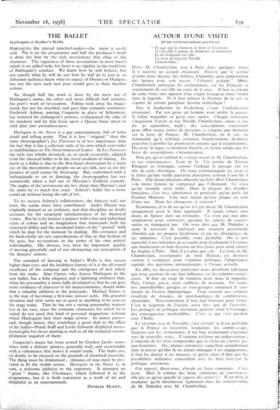THE BALLET
Harlequin at Sadler's Wells
HARLEQUIN, the eternal mischief-maker—the name is easily said. Put it on the programme and half the producer's work is done for him by the rich associations that cling to the character. The vagueness of those associations in most men's minds is an added help, for there is no rigidity in the traditions of Harlequin's conduct. We know how he will behave, but not exactly what he will do nor how he will do it, just as an Athenian audience knew what to expect of Orestes or Oedipus, but not the turn each new poet would give to their familiar actions.
So, though half the work is done by the mere use of Harlequin's name, the other and more difficult half remains, the poet's work of re-creation. Fokine took away his magic- wand, but not his mischief, and gave him romantic sentiment. Frederick Ashton, putting Couperin in place of Schumann, has restored his poltergeist's powers, resharpened the edge of his mockery and let him loose upon a Queen Anne street to stick pins into pretentiousness.
Harlequin in the Street is a gay entertainment, full of witty detail and telling point. That it is less " original " than the same choreographer's Les Patineurs is of less importance than the fact that it has a coherent style of its own which over-rides its indebtedness to The Good-humoured Ladies. In Les Patineurs the style was wholly invented, or, to speak accurately, adapted from the classical ballet to fit the novel medium of skating. Its merit as a ballet is due to the first-hand observation by a witty eye of the movements of people on an ice-rink, just as are the pictures of such scenes by Avercamp. But, confronted- with a harlequinade to set to dancing, 'the choreographer has not unnaturally taken a leaf out of Massine's Goldoni comedy. The angles of the movements are less sharp than Massine's and the satire by so much less cruel. Ashton's ballet has a more genial air without losing the salt of wit.
To its success Ashton's collaborators, the dancers and, not least, the scenic artist have contributed. Andre Derain was originally trained as an architect, and that discipline no doubt accounts for the structural satisfactoriness of his theatrical scenes. But he is by instinct a painter with a fine and individual sense of colOur and an imagination that transcends both his structural ability and the accidental forms of the " period" with which he may for the moment be dealing. His costumes and his back-cloths are not reproductions of this or that fashion of the past, but re-creations in the terms of his own artistic individuality. His dresses, too, have the important quality of moving gracefully and of not obstructing our perception of the dancers' actions.
The standard of dancing at Sadler's Wells is this season higher than ever, and the healthiest feature of it is the all-round excellence of the company and the emergence of new talent from the ranks. Alan Carter, who dances Harlequin in the new ballet, has a lithe elegance and a lightning swiftness that, when his personality is more fully developed so that he can give more vividness of character to his impersonations, should make him a valuable addition to the principals. Michael Somes is in the way of becoming a first-rate danseur noble. His graceful elevation and slow turns are as good as anything to be seen on the stage today. That he has not a strong personality matters less in his case, since the romantic characters for which he is suited do not need that kind of personal magnetism without which Harlequins lack their magic power. In minor parts— and, though minor, they contribute a great deal to the effect of the ballet—Frank Staff and Leslie Edwards displayed unsus- pected gifts for clever miming as well as all the technical accom- plishment required of them.
Couperin's music has been scored by Gordon Jacob, some- times with a delicate aptness, generally well, and occasionally with a vehemence that makes it sound crude. The faults are, no doubt, to be excused on the grounds of theatrical necessity. The thing must be dramatised ; climaxes of tone must be prc- vided to fit the visible action. Harlequin in the Street is, in sum, a welcome addition to the repertory. It attempts no " great " theme, like Checkmate, which followed it in the programme, but it is both consistent as a work of art and delightful as an entertainment.
DYNELEY HUSSEY.
























































 Previous page
Previous page